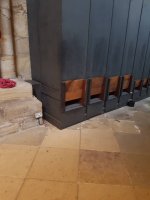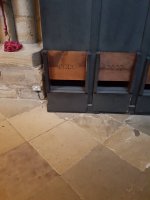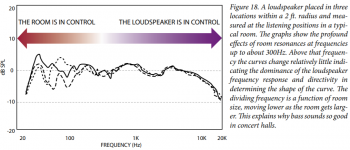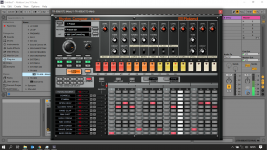I think those Axi plots might be from my measurements that I sent to Camplo. That is my system that Ro808 posted pictures of earlier. I would like to post here more but just haven't had the time these last few months!
I have the OB Fane Colossus XB from 35Hz to 330Hz and the Axi from 330Hz all the way up. I might look at using papier mache as per Inlow on the outside as they are rather thin but not sure if this is a real or imagined problem.
Would like a 150Hz pair of the Cowan wooden horns shown further up or a pair of Markus Klug multi cell horns eventually.
What is the opinion here on those multi cell horns?
I have the OB Fane Colossus XB from 35Hz to 330Hz and the Axi from 330Hz all the way up. I might look at using papier mache as per Inlow on the outside as they are rather thin but not sure if this is a real or imagined problem.
Would like a 150Hz pair of the Cowan wooden horns shown further up or a pair of Markus Klug multi cell horns eventually.
What is the opinion here on those multi cell horns?
I think this phenomenon about group delay and the lower spectrum is akin to the argument that sound below 200hz or is it 80hz, or what ever number you choose, isn’t locatable...to where this may be true for the general audience but some of us are more sensitive than others, yet more importantly, it’s just not detrimental to the experience.
Well from my experience everybody can locate 80hz... in the required conditions: either some very big room or outside.
Once you are in a room and below schroeder frequency the room dominate the reproduction and every bets are off wrt outcome in low end ( even simulations used by acousticians are only what they are, they often only gives guideline and i witnessed this a few times.). Given the room volume schroeder frequency change and thus ability to locate low end follow. I'm almost sure this happend as i was unable to locate subs xover at 150hz in mid sized room and heard outside as low as 80hz pan and phase effects.
What happens is that even though it’s not taking away from the pleasure of audition it is changing the actual waveform and if you had a system who’s group delay within the bass was high but acceptable and direct comparison to a system with outstanding group delay performance, you will hear a difference and the system with the better group delay is more honest, so as a sound engineer you should desire the best group delay possible.
We are in agreements as it is more or less what i stated earlyer in this thread. That said 'the best group delay possible' doesn't make sense by itself. There is an audible threshold which is frequency dependent so as you stay below this it should be all good to trick our brain.
And anyway the room will skrew things up.
I have found that with headphones I can be very meticulous with the crafting of bass compression because the group delay is so tight that I can hear the changes...amongst no room as well I guess. Group delay is to bass or signal in general as is the attack setting of the envelope. The woofer group delay at 50hz may be 25ms BUT the driver has the signal already at reference 0ms....so from 0 to 25ms it gradually reaches full amplitude, a crescendo, if you will. No different than the attack setting of the envelope. So from a purely spectators perspective maybe that’s fine, a minuet spin on the artist (engineers) original vision/intentions but, for the truest sense of critical listening, no. Am I worried about it? Not really because group delay among a lot of other things make super accurate bass production a huge (expensive) challenge, so....I have headphones for the intricate details and I use the loud speakers for level assessment. Transient response , is a somewhat controversial topic is it not, especially when talking about bass? Well group delay literally changes the transients shape from sharp to soft, the more extreme it gets.
I don't agree with your example of envelope and attack settings. I see what you mean but you forget one thing ( very important) in my view: your setting is frequency dependent and room will interfere. The point being where is the limit of audibility of phenomenon.
That said yes taking the room out of the equation with headphone is the way to go for certain operations. Comp and eq.
Do you have evidence of group delay being low with your headphone? Maybe from some dsp treatements but otherwise as they are finite bandpass design they mandatory have gd in low end.
Transient response , is a somewhat controversial topic is it not, especially when talking about bass? Well group delay literally changes the transients shape from sharp to soft, the more extreme it gets.
Maybe it is for you, for me it is not. Bass is all about transient ( ok let's say 80/20 with some sustained unatural generated source and organ). Anyway we are transient analyzer for audio. Just cut the first ms of any source sound and try to tell which kind of instrument family it is...
About what do you think it is controversial?
Last edited:
Yes either that, ... variations. I wouldn't necessarily say the same about time of flight delay.
Could you elaborate on that AllenB please?
If there were more accurate studies about perception of x-over induced GD distortion I am convinced it would be easy to design speakers that are blameless in this respect even with analogue technology.
Regards
Charles
Regards
Charles
Some observations on group delay
But as krivium says, once you are in a room and below Schroeder frequency the room dominate the reproduction...
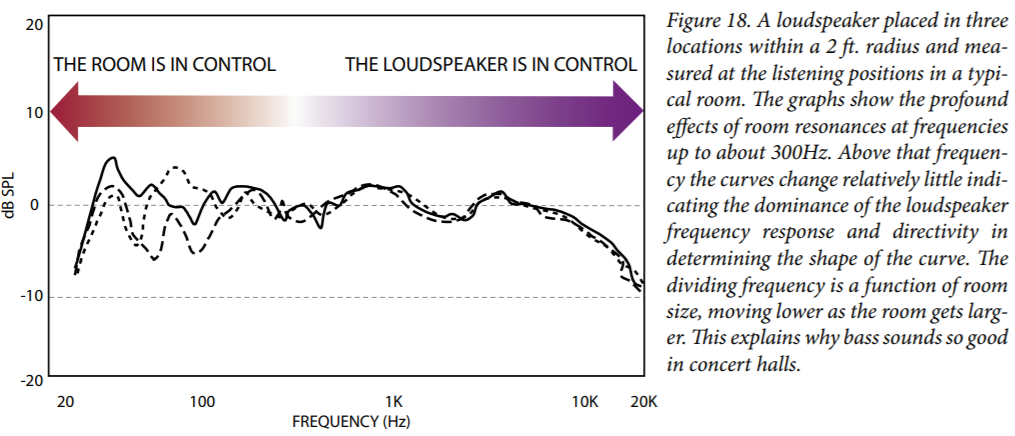
See https://www.harman.com/sites/default/files/AudioScience_0.pdf and Room Modes 101 - Acoustic Frontiers
But as krivium says, once you are in a room and below Schroeder frequency the room dominate the reproduction...
See https://www.harman.com/sites/default/files/AudioScience_0.pdf and Room Modes 101 - Acoustic Frontiers
Attachments
Looks familiar, I get the same/similar variation near the LP in my room.
But while we are talking about group delay distortion, especially around crossover, why aren't we talking about using FIR to correct it?
Or using FIR to correct group delay for the first octave above cutoff on a JMLC horn instead of not using that first octave because of its high group delay?
But while we are talking about group delay distortion, especially around crossover, why aren't we talking about using FIR to correct it?
Or using FIR to correct group delay for the first octave above cutoff on a JMLC horn instead of not using that first octave because of its high group delay?
Well from my experience everybody can locate 80hz... in the required conditions: either some very big room or outside.
Once you are in a room and below schroeder frequency the room dominate the reproduction and every bets are off wrt outcome in low end ( even simulations used by acousticians are only what they are, they often only gives guideline and i witnessed this a few times.). Given the room volume schroeder frequency change and thus ability to locate low end follow. I'm almost sure this happend as i was unable to locate subs xover at 150hz in mid sized room and heard outside as low as 80hz pan and phase effects.
We are in agreements as it is more or less what i stated earlyer in this thread. That said 'the best group delay possible' doesn't make sense by itself. There is an audible threshold which is frequency dependent so as you stay below this it should be all good to trick our brain.
And anyway the room will skrew things up.
I don't agree with your example of envelope and attack settings. I see what you mean but you forget one thing ( very important) in my view: your setting is frequency dependent and room will interfere. The point being where is the limit of audibility of phenomenon.
That said yes taking the room out of the equation with headphone is the way to go for certain operations. Comp and eq.
Do you have evidence of group delay being low with your headphone? Maybe from some dsp treatements but otherwise as they are finite bandpass design they mandatory have gd in low end.
Maybe it is for you, for me it is not. Bass is all about transient ( ok let's say 80/20 with some sustained unatural generated source and organ). Anyway we are transient analyzer for audio. Just cut the first ms of any source sound and try to tell which kind of instrument family it is...
About what do you think it is controversial?
Headphones - 1.2 - Graph - RTINGS.com
(HD600 Sennheiser) The measurements I just looked up says I have 5ms of GP at 20hz, and it declines to 2ms or less by the time it reachs 50hz and then decreases further of course, up stream.
If you see what I mean then you must agree! Group delay performs just like the attack setting of the envelope, you just have to consider that it is "dynamic"....the group delay spec would specify the spec of the attack setting per frequency in, ms. If a woofer has a group delay of 50ms at 50hz, and you play a 50hz tone, amplitude will go from 0db to full signal, gradually, taking 50ms to get there.
Personally I have never, not been able to locate the sub...nor I do foresee it possible to be un-locatable but its not like I've set out on a scientific endevour to prove it one way or another lol....Most of the time there is tactile feed back involved with loud sub playback and that doesn't help the cause of "hiding" if you are sensitive to that, like I am. That is neither here nor there, we are speaking of room vs source presentation below the schroeder frequency, as well as bass transient performance. Being controversial.. Thats just my interpretation of what I see on the internet as far as being "controversial"....really the controversy surrounds what exactly is responsible for the outcome performance; inductance, sealed vs ported....BL, MMS, QTS.... there's all sorts of discussion on it, and they all play a part but group delay is likely the major factor to look at after all else has been sorted... All else equal... a woofer that has a very high group delay through-out the bass region, vs one that has 0 group delay ...the 0 group delay is going to be tighter, punchier, and more immediate....lets just say that both sound acceptable, because of the tolerance of the human perception in that aspect....the very high group delay driver is essentially coloring the sound. The room is a sympathetic reaction to the source...so though it may blur things due to hangover, since music is a continuous performance of signals....the tactile feedback as well as conscientiously searching for the difference been the presentation of an 808 in my head phones vs my loudspeaker, results in a difference that I can perceive easily. Yeah, it doesn't sound incorrect either way, but one is lying and one is....less lying. Lets not forget that in sound engineering, a bass with a slow attack on the envelope (ie higher than 0ms) is often a desirable thing, from a creative standpoint. 10ms renders a nice warm feel, 20-50ms is a nice soft glow, as well. Start getting towards 100ms and its a lot more noticeable, yet its within creative norm. A woofer with a 50ms GP (yes I know the number changes per frequency but lets generalize please) in the bass...is not going to compound delay if a bass instrument has a 50ms attack envelope as well....but every bass source signal with an attack under 50ms is going to be rendered as if it has a 50ms still because the GP delay represents how long it takes the driver to go from 0db to source level at given frequency. So whats happening here is we are saying that higher group delay in the bass region isn't perceivable and thats a lie. The truth is, High group delay in the bass region is still musical, as well as, perceivable when compared to another system with significantly different GP delay specs. Can you tell the difference between 2ms and 10ms, visually? I can, I bet you can too but maybe not. What about the difference between 1ms and 5ms...I can still perceive a slight drift visually, but with group delay, and one vs the other woofer, a 4ms difference from 0db to 90-db....thats not gonna be very noticeable since they both are still making sound at 0ms....but at 20ms group delay vs 5ms, I guarantee I can hear the difference... but as a sound engineer I play with compressors and envelope settings, so it is apart of the profession to hear these things, a required skill, mind you....With sound, if you have no reference to what the true signal sounds like....its easy to say that something is "fine" when you are unbothered by it. In the case of the rooms contribution....the room cannot start until the the source starts. The room introduces diverse phase, unless its the "perfect room"...Group delay, could alter the perceived frequency curve because of that fact. The room can change the resulting group delay if you aren't getting the direct signal first or at a level constrastingly higher than the room energy. Thats how I feel about it anyway....I wouldn't just scoff at group delay as a spec that can be somewhat ignored if critical listening is the goal. Call me a signal elitist, or at least a wonna be =). The difference between the sealed and ported 18h+ is 4ms (4ms and 8ms)....at 30hz....so unless I want to talk about decay...I wouldn't be loosing if I go ported. I wonder what is the general difference in decay between the two designs.
I think those Axi plots might be from my measurements that I sent to Camplo. That is my system that Ro808 posted pictures of earlier. I would like to post here more but just haven't had the time these last few months!
I have the OB Fane Colossus XB from 35Hz to 330Hz and the Axi from 330Hz all the way up. I might look at using papier mache as per Inlow on the outside as they are rather thin but not sure if this is a real or imagined problem.
Would like a 150Hz pair of the Cowan wooden horns shown further up or a pair of Markus Klug multi cell horns eventually.
What is the opinion here on those multi cell horns?
Keith, your system is closest to the thread title so far. I like the 'simplicity', as I like the RCA-inspired 2-way on the previous page.
You've have replaced an (often considered) ideal topology (4-way) with a 'compromised' one.
How would you compare both systems, especially wrt reproduction of high frequencies?
The multi-cell horns are very interesting indeed. It's been shown in various tests by P. Newell and K. R. Holland, as well as JMLC (ETF 2010), these don't exhibit typical horn artefacts, while at the same time allow very low crossover points.
Evidently, multi-cells aren't perfect, but very pleasing to the ear, according to the people who've listened to those.
Last edited:
In Durham Cathedral......Not suitable domestically methinks.
True, but fortunately only need a small fraction of a cathedral's sheer acoustic power to [over] power a typical consumer app. 😉
GM
According to Georg Neumann: "The subjective effect of excessive group delay is a “loosening” of the bass or a “less dry” bass quality."
Interesting findings about the audibility of GD are found in this thread.
Interesting findings about the audibility of GD are found in this thread.
Last edited:
Sure, but sorry which part?Could you elaborate on that AllenB please?
I assume the time of flight, like you suggested I would work with the GD. The goal would be to find the matching phase slope. Delaying based on physical measurements is not likely to be as effective/accurate.
Last edited:
The room is a sympathetic reaction to the source...so though it may blur things due to hangover, since music is a continuous performance of signals....the tactile feedback as well as conscientiously searching for the difference been the presentation of an 808 in my head phones vs my loudspeaker, results in a difference that I can perceive easily. Yeah, it doesn't sound incorrect either way, but one is lying and one is....less lying. Lets not forget that in sound engineering, a bass with a slow attack on the envelope (ie higher than 0ms) is often a desirable thing, from a creative standpoint. 10ms renders a nice warm feel, 20-50ms is a nice soft glow, as well. Start getting towards 100ms and its a lot more noticeable, yet its within creative norm.
"A TR-808 bass drum note is produced when the µPD650C-085 CPU applies a common trigger and (logic high) instrument data to the trigger logic. The resulting 1-ms long pulse is delivered via the pulse shaper to the bridged-T network (a band pass filter), whose ringing produces the core of the bass drum sound. The 1-ms long pulse also activates an envelope generator, which alters the bridgedT’s center frequency for the first few milliseconds and supplies a retriggering pulse to the center of the bridged-T network after a few milliseconds. Leakage through the retriggering pulse circuit accounts for “sighing” of the bass drum’s pitch."

This is how the TR-808's emulated bass drum circuit is supposed to work. More info here.
Here's the paper for the cymbal circuit.
Due to ageing of components differences between individual real TR-808s are common.
Last edited:
Lol you went real technical on that one Ro808 lol, the 808 instrument is a very ambiguous name nowaday though it is still used distinctively for the originating instrument or now, a vst simulation, or sample, or anything that sounds like it could have originated from the 808 or inspired by it. Non the less, in current music, it’s envelope parameters are all tweak-able, from attack to release to starting freq to ending to everything in between, sine to square waveform, crunched into distortion even, so 808 is just a basic way to say “electronic generated bass signal” thst is some kind of derivative of the original instrument, that usually starts and then fades away but even then some are set to hold the note until the key is let go, and then release/decay/sustain settings take over. Kinda like saying bass guitar.
What's my name again? 
An externally hosted image should be here but it was not working when we last tested it.
Last edited:
Hi guys great thread. Thought this might be useful. Lean Business is now stocking Celestion's new LH9045 horn for their axi driver!
Celestion LH9045R 2 90 x 45 Wide Bandwith Horn
😀😀😀
Celestion LH9045R 2 90 x 45 Wide Bandwith Horn
😀😀😀
Attachments
Thanks for notifying!
These are not exactly cheap at £950.00 for the LH9045R and £1,050.00 for the LH6040R.
A Klipsch K402 is only slightly more expensive, and probably (a lot) cheaper in the US due to shipping costs.
These are not exactly cheap at £950.00 for the LH9045R and £1,050.00 for the LH6040R.
A Klipsch K402 is only slightly more expensive, and probably (a lot) cheaper in the US due to shipping costs.
imho a much better solution:
Wood Horn F280A / Yamamoto Sound Craft
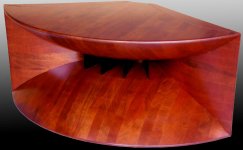
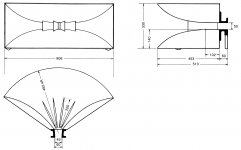
Does anybody know if these horns are still in production?
Wood Horn F280A / Yamamoto Sound Craft


Does anybody know if these horns are still in production?
- Home
- Loudspeakers
- Multi-Way
- Is it possible to cover the whole spectrum, high SPL, low distortion with a 2-way?
